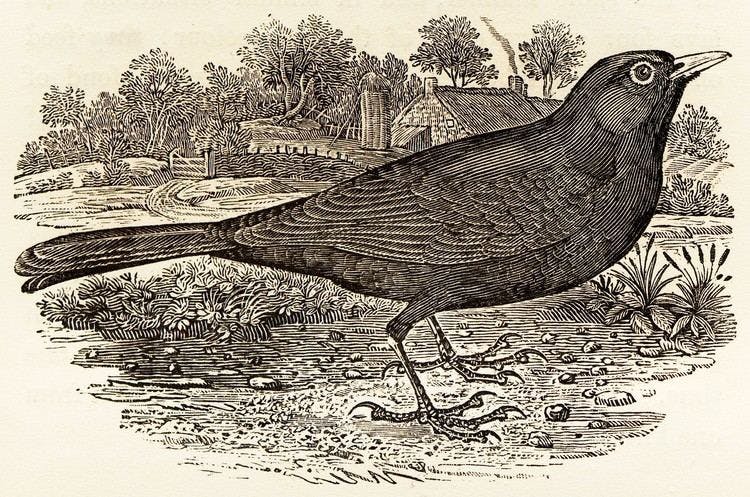First Published for 5x5x5 online festival hosted by The Arts Institute at Plymouth University in 2020. The text was written in response to the provocation: Everything is changing. Nothing has changed. Change is coming.

Thomas Bewick, Woodcut from History of British Birds, 1797-1804
Reading time 5'
How has 2020 been for you? For the novelist Arundhati Roy the pandemic has been a portal, offering a gateway from one world into another. I think of it is as a megaphone; amplifying and accelerating existent vulnerabilities and inequalities. While Covid-19 is a new pathogen it has brought nothing new to society. Unfortunately, it comes as no surprise that precarious and marginalised communities have faced the full violent force of the pandemic. My questions are: what can cultural organisations do with this moment of crisis? How do we use our current grief?
Crisis has historically been used to articulate a moment of transformation forced by difficulty. In Greek theatre, it was understood as a decision — a narrative device used to resolve conflict. In other words, it is a type of question brought into sharper focus, offering a moment of reckoning where the state of how things are can be re-imagined. Collective trauma has often generated fresh possibility. For instance, the bubonic plague accelerated progressive social demands with a diminished labour market negotiating for worker’s rights. The NHS grew out of a welfare state made possible by the trauma of war.
The pandemic has seen cultural organisations grapple with new ways to communicate in an attempt to create social intimacy at a time of physical distancing. This rush to the digital — the endless zoom talks, links and virtual tours — mirrors the exhaustive logic of cultural over-production that has pervaded the sector for many years. The sense of crisis has created a performative urgency from institutions eager for attention in an era of mass distraction. This over-production is unsustainable and is often made possible by the exploitation of cheap and flexible labour. If the virus is a megaphone, amplifying and accelerating what already exists, museums should move away from the noise and deepen their listening to re-imagine how things might be.
I recently came across the work of field recorder Bernie Krause who has spent years studying sound in forests. Krause coined the term "animal orchestra", surmising that animals co-operatively evolve their communication with other species finding their own tone and frequency. Nature has an auditory bandwidth that is mutually supportive, forming a kind of sonic civility. The sound of nature is polyphonous rather than cacophonous. Animals communicate to and with each other rather than over and for each other.
What might cultural organisations learn from the animal orchestra? How can they speak with rather than over their communities? Let’s start by moving away from the authority of the institution and lose ourselves in the forest.
If we view culture as a space for contesting value, the museum becomes a campfire where communities congregate to share commonalities and value difference. Meaning remains kinetic as stories are re-told and re-purposed. While the artefact is arguably that — fact, much around it is someone’s opinion. Speaking with an artefact rather than over it means opening up a space of uncertainty — asking the questions so we that we can share the answers.
Uncertainty and vulnerability are often denigrated and I’m interested in how institutions reclaim these ways of being to re-imagine how things might be. We can see this as a perpetual form of symbolic crisis that destabilises the known by embracing the uncertain. Perhaps curators are like Bernie Krause, listening out and attending to the bandwidth, trying to decipher the melody amid the cacophony and attempt to find the underlying rhythm.
When Krause analysed many of his recordings he noticed that there were gaps in the sonic landscape, realising that this auditory lacuna was the absent sound of extinct animals. Similarly, through a process of deep listening museums can start to understand what questions have been silenced and what stories are not being told. If the virus is a megaphone then museums must share uncertainty and create forms of programming that involve modes of deep listening.
From "Let’s Take Back Control" to "Make America Great Again," populist rightwing politicians have monopolised the rhetoric of change. Museums need to reclaim the narrative of crisis and redouble their efforts to co-produce socially progressive stories. By slowing down and opening up, cultural organisations can start to decentre their own authority, widen the bandwidth and enable people to find their own frequency.
My abiding memory of 2020 has been joining in with my neighbours as we clap for key workers during lockdown. From sonic civility to the sound of solidarity. My hope for 2021 is that cultural organisations help us to lament what is lost and reimagine what might be through restorative storytelling. As we pass through the portal we need to make sure we use our grief to imagine into action a new world that is more sustainable, equitable, attentive and pleasurable.